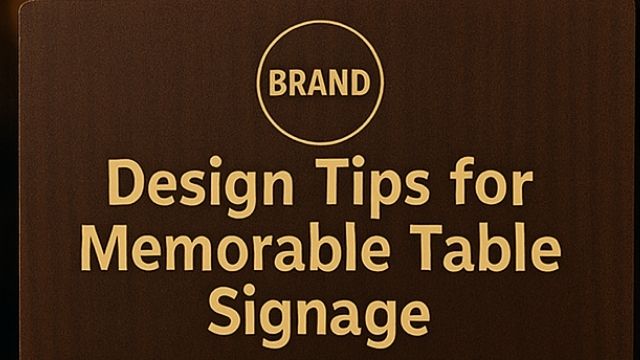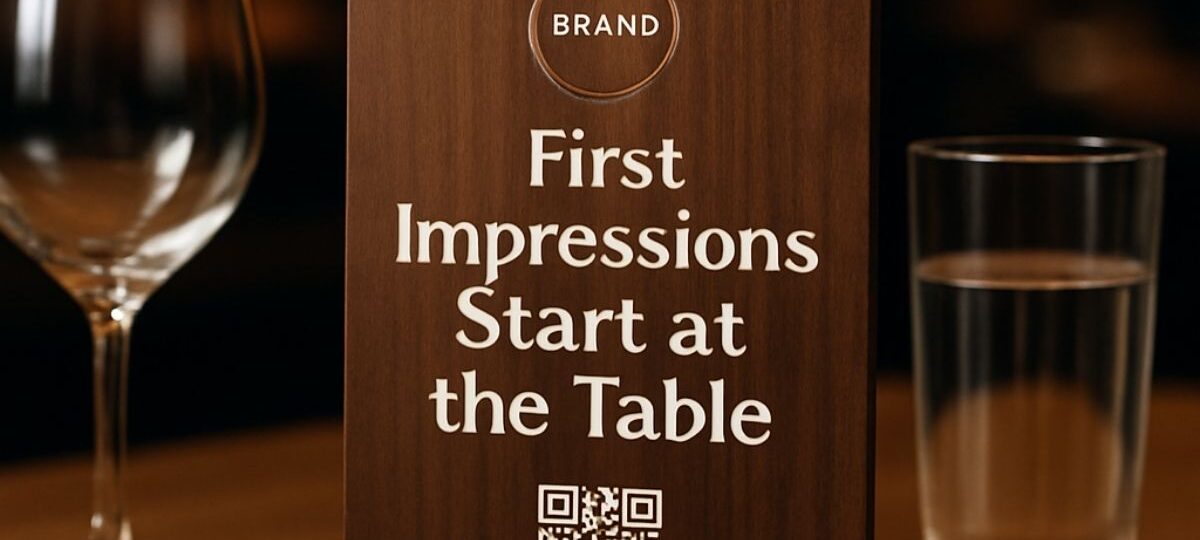First Impressions Start at the Table
Guests form opinions instantly, just seconds after seating. According to hospitality experts, it takes about 10 seconds for a first impression to crystallize. That slight pause before server introductions is crucial: a well-curated table stand shows intentionality and sets an inviting vibe. Think of it as your brand’s handshake—the first silent greeting.
What Guests Notice (Even if They Don’t Realize It)
Alignment, Spacing & Ergonomics
Ever noticed how slightly askew signage feels sloppy, even if you can’t pinpoint why? Guests read subtle cues—centered text and comfortable spacing suggest professionalism. A clean, ergonomic layout tells them someone cared about their comfort.
Material Quality: Wood, Acrylic, Metal
Guests instinctively judge materials: warm wooden stands feel premium, reflective acrylic feels modern, and brushed metal signals industrial chic. Each material sends a subtly different message about your brand’s identity.
Cleanliness and Upkeep
Even small smudges or scratches can undermine trust. Un-kept signs create a subconscious belief that other areas—like food prep—may be similarly neglected. Maintaining flawless signage reflects hygiene standards that guests appreciate.
Why Visual Consistency Builds Trust
Matching Stands with Menus & Uniforms
Consistency across touchpoints—table signage, menus, staff attire—reinforces brand clarity. If each element speaks the same visual language, guests perceive coherence and professionalism. Inconsistency, on the other hand, feels disjointed and sloppy.
Reinforcing Brand Personality
From playful to polished, table stands should reflect tone and identity. A quirky café can use colorful graphics and casual copy, while a luxury hotel might favor sleek fonts and muted tones. This alignment deepens emotional impact and strengthens the brand narrative.
Design Tips for Memorable Table Signage

Contrast and Readability
Ensure high-contrast text for visibility under dim lighting—crisp readability avoids frustration and guides the guest experience effectively.
Logo Placement & Hierarchy
Establish visual flow:
- Brand first (logo at the top)
- Main message (promotion or theme)
- CTA (like “Scan here”)
This structure helps guests capture key info quickly.
Voice and Tone in Microcopy
Whether cheeky (“Today’s secret special 🍽️”) or elegant (“Tonight’s chef’s selection”), microcopy personalizes the interaction and reinforces brand tone.
QR Codes & Digital Integrations
Modern hospitality blends physical and digital. Wooden or metal stands with integrated QR slots feel premium AND functional—using design to connect tactile and digital experiences seamlessly.
Table Stands That Make a Statement
INKO produces high-end table stands in materials like leather, wood, acrylic, and metal. They promise global delivery within 1–2 days, aimed at professionals in over 45 countries. Their stands often feature custom engraving and integrated digital touches—ideal for modern hospitality settings. Visit their website to find more high-end tables: https://inkohoreca.com/collections/table-stands
Strategic Benefits Beyond Beauty
Upselling & Guest Engagement
Studies show well-designed signage can boost featured item sales. A focused upfront display drives action—like highlighting the chef’s desserts, increases visibility (and sales).
Efficient Service and Guest Convenience
Stand prompts like “Scan for assistance” let guests take control, reducing interruptions and allowing staff to focus on delivering quality service.
Storytelling and Nurturing Loyalty
Table signage can tell your brand’s story—sourcing practices, chef background, signature experiences. These connect emotionally, building deeper loyalty and engagement.
Choosing the Right Stand for Your Space
Material vs. Ambience
Match materials to vibe: rough-hewn wood for rustic cafes, polished metal for industrial-chic venues. Aligning material choice with ambience amplifies brand-customer connection. https://inkohoreca.com/collections/table-stands
Functionality Meets Aesthetics
Do your stands need to be wipeable, heat-resistant, or QR-ready? Choose materials and finishes that won’t warp or degrade under heavy use or outdoor conditions.
Budget Tiers and Longevity
Premium materials cost more upfront but last longer—worth it for high-rotational environments. Budget-friendly acrylic or bamboo can work for lower-traffic areas, but factoring in replacement cost is key.
Maintenance & Hygiene
Cleaning Schedules
A daily wipe-down with a soft microfiber cloth and mild cleaner preserves appearance and prevents germ build-up.
Handling Wear and Environmental Challenges
Outdoor spaces need UV-resistant coatings or water-sealed finishes—quartz-treated stands resist fading, cracking, and moisture.
Future‑Proofing: Trends into 2025
Sustainable Materials
Eco-friendly stands made from reclaimed wood, bamboo, or biodegradable plastics reflect a growing demand for sustainable hospitality credentials .
Contactless Integrations & Smart Stands
Lang 2025 sees NFC chips, AR menus, and voice-triggered menus—smart stands that elevate guest interaction in seamless, tech-forward ways.
Measuring ROI on Table Stand Investments
Guest Feedback & Perception Studies
Simple survey prompts (“Did this table stand enhance your experience?”) gather firsthand impressions. Over time, trends indicate impact on perceived ambiance.
Tracking Sales Uplifts on Promoted Items
Use POS data to compare item performance before vs after signage deployment—uplifts in featured items directly quantify ROI.
Conclusion
Every element of your restaurant—including table stands—impacts guest perception. From the material chosen to microcopy on a stand, small touches shape big impressions. Strategic, well-designed, and clean signage communicates brand quality, boosts sales, and fosters emotional loyalty. In 2025’s saturated hospitality industry, details like these set you apart—and providers like INKO make it both achievable and scalable.
FAQs

1. How often should I refresh table signage?
Inspect stands monthly; replace or refresh whenever visuals fade or messaging becomes stale (typically quarterly for high-use venues).
2. Are wooden stands hygienic?
Yes—with sealed finishes they clean easily and resist bacteria—just treat them as you would polished wood furniture.
3. How do I test new sign ideas?
Pilot signage in select sections and track differences in upsells or guest survey feedback—A/B testing works well.
4. Does QR sizing matter?
Definitely—ensure your QR slots are sized and printed so the code stays flat and scannable under any lighting.
5. Can signage be part of my sustainability branding?
Absolutely—use recycled, FSC-certified, or biodegradable materials and note that on the signage itself to reinforce your eco-commitment.
See Also: Office Furniture – A Reflection of Your Brand’s Identity









